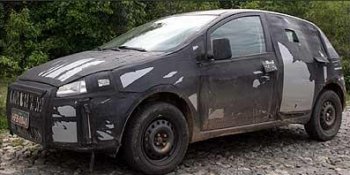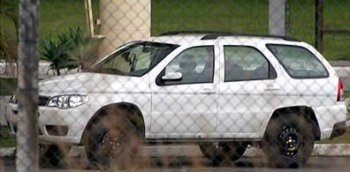|
A wave of new
Fiat models are currently being developed in Brazil. Fiat Autom˛veis'
giant Betim assembly plant in the Minas Gerais region, which
this year has celebrated its 30th anniversary, is at present
the scene of much engineering activity.
The first model to
arrive on the South American markets will be a final facelift for the decade-old Palio
hachback which has in recent months assumed leadership of
its market segment, pushing the VW Gol, the traditional
leader, into second place. This will be its most dramatic
makeover yet, moving the Palio's position
upwards to follow a growing car buying trend that is seeing South
American drivers' seeking out larger and more luxurious
vehicles to enhance their status.
The new Palio model will follow very closely the styling
set out by the Chinese built Fiat Perla earlier this year, which is
in turn based on
the Siena sedan, the platform-sharing sister car to the Palio in the "Project
World Car" family. The Perla was developed by Nanjing Fiat,
the 50-50 Fiat Auto joint venture business in China, with
strategic engineering input
from Fiat Autom˛veis; and the project's aim was to firmly
reposition the sedan upmarket. The new Palio will visually
follow this theme at the front but with an even larger
slatted radiator
grille, which is pronounced by its new sharper edges an
complemented by three horizontal cut-out sections at the top
of the bumper. The
front bumper is carried over from the Perla although Fiat's Brazilian
development team have made the lower spoiler section slightly deeper.
It also gets mist lights.
At
the back the new Palio gets a more bulbous and deeper bumper
to help it stand out. The bumper cut-outs have gone and in
their place the middle is recessed to house the registration
plate which is moved from its previous position in the
tailgate which a raised lip across the bumper below the
plate gives it a new profile.
|

 |
|
The Grande Punto is now
being tested in Brazil (top) while a Palio Weekend
prototype (above) reveals that Fiat Autom˛veis is
developing four wheel drive. Photos:
Estado de
Minas. |
|
|

 |
|
The new Palio
model will follow very closely the styling
set out by the Chinese built Fiat Perla earlier this year, which is
in turn based on
the Siena sedan, the platform-sharing sister car to the Palio in the "Project
World Car" family.
Photos:
Estado de
Minas. |
|
|
The rear light of the new Palio are also brand new: smaller
and smoother in shape than the outgoing units they no longer
rise sharply into the rear screen, and will also receive new
lens patterns. Finally a new tailgate features a smaller
rear screen and a smoother feel with the reposition of the
registration plate.
Meanwhile, beefing up the
Fiat range in the South American region will be taken a step further
when the Grande Punto commences assembly at Betim. Already
hugely successful in Europe, and set to be built in both India and
Russia, the new 'supermini' will be very heavily revised by Fiat
Autom˛veis to incorporate their own technology and
mechanical components. Just as Brazilian-built Fiat models such as the
B-segment 'mini MPV' Idea are fundamentally different under
the skin from their European counterparts, so the Grande
Punto will also be revised, from an engineering aspect, when
it rolls out of Betim. Finally, the Brazilian press has
recently featured photos purporting to show Palio Weekend
prototypes fitted with four wheel drive, raising hopes that
this traction could be soon extended to the "Adventure"
range.
Additional reporting by Claudio Perlini
|
|
|
|